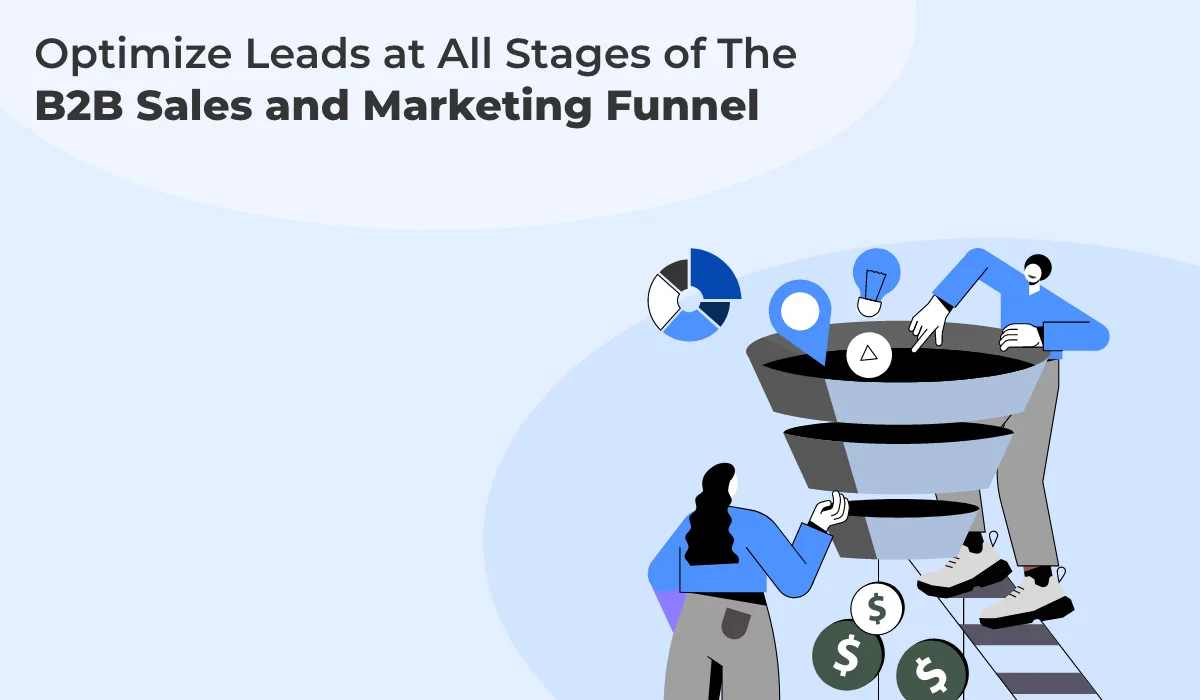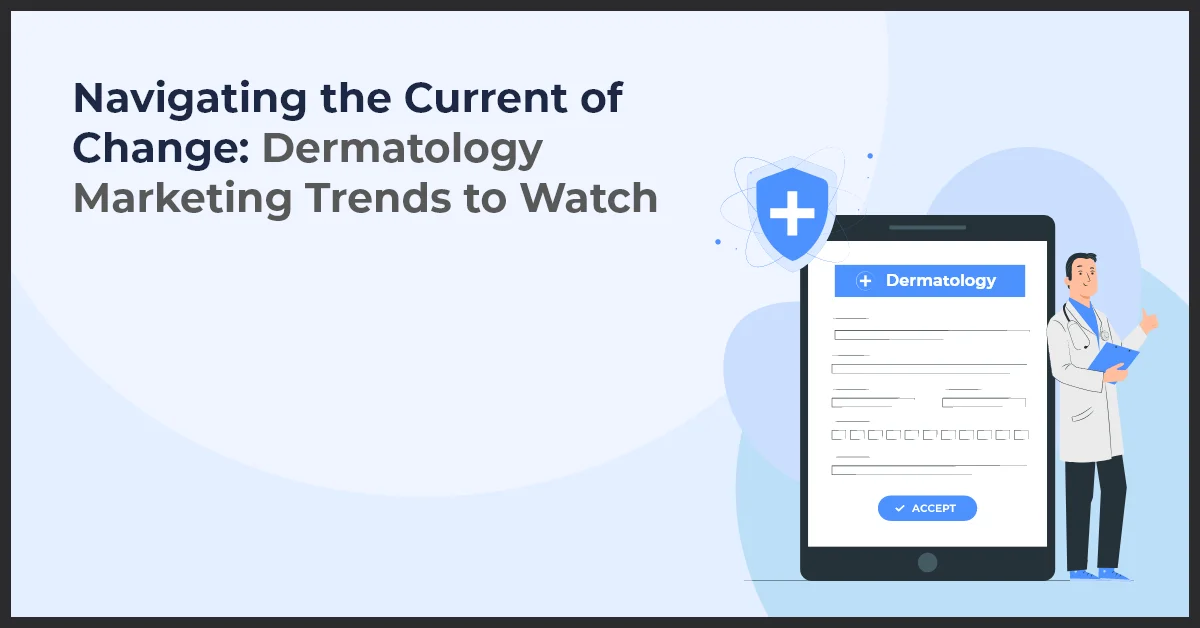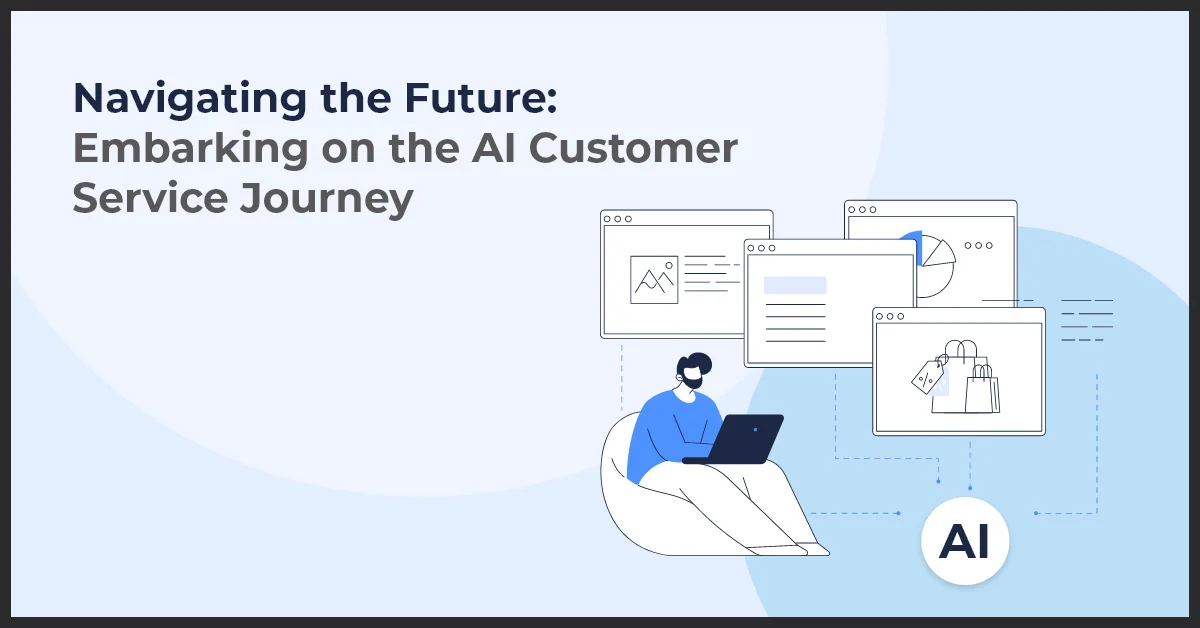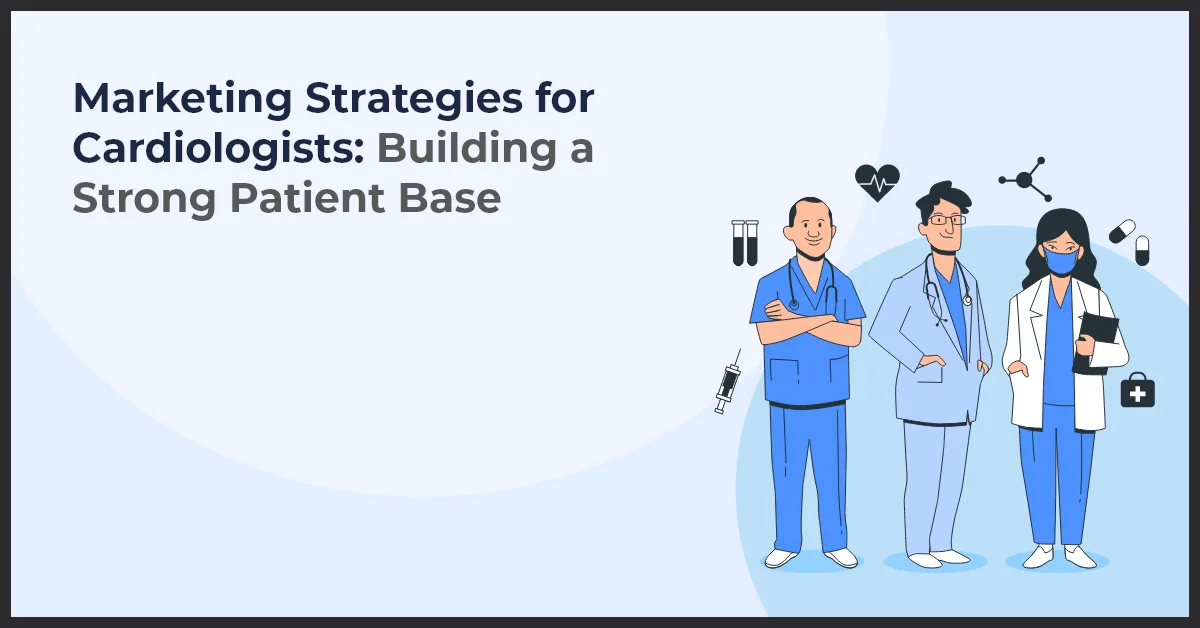Optimize Leads at All Stages of The B2B Sales and Marketing Funnel

Published on: April 22, 2020
Updated on: June 26, 2024
798 Views
- Digital Marketing
16 min read
B2B Marketing in today’s world is more complex than ever. Personas are complicated, Marketing technology stacks are ever-evolving, marketing channels intertwined.
You want to build a marketing experience that generates meaningful customer engagements both online and offline, high conversion rates powered by marketing automation, and omnichannel marketing. All this to drive one thing, Growth!
Understanding the Customer
In order to create an effective B2B marketing funnel, it is crucial to first understand your target audience and their specific needs in the B2B space. By identifying and addressing their pain points, you can develop a targeted marketing strategy that resonates with your potential customers.
Identifying the target audience and their needs in the B2B space:
- Research and segment your target audience based on industry, company size, job function, and other relevant demographics.
- Understand their challenges, goals, and priorities in order to tailor your messaging and offerings to meet their specific needs.
- Conduct surveys, interviews, and analyze customer data to gain insights into their pain points and preferences.
Creating buyer personas to understand customer motivations and pain points:
- Develop detailed buyer personas that represent your target audience segments.
- Outline their motivations, objectives, challenges, and pain points.
- Use these personas to guide your marketing efforts and create messaging that speaks directly to their needs.
Conducting market research to gather insights on customer preferences:
- Research your target market and industry trends to gain a deeper understanding of customer preferences.
- Identify competitors and analyze their marketing strategies to identify gaps and opportunities.
- Utilize tools and resources such as surveys, focus groups, and online analytics to gather quantitative and qualitative data about your customers.
Defining the B2B Product and Value Proposition
When it comes to B2B marketing, understanding the unique features and benefits of your offering is crucial. It allows you to effectively communicate what sets your product apart from competitors and how it brings value to your target audience.
In order to define the B2B product and value proposition, you need to dive deep into the features and benefits that make your offering special. Identify what problems your product solves, what pain points it addresses, and how it can improve your customers' businesses.
Crafting a compelling value proposition
Once you have a clear understanding of your product's unique features and benefits, it's time to craft a compelling value proposition. Your value proposition should resonate with your target audience and clearly communicate the value your product brings to their business.
When crafting your value proposition, focus on the specific benefits your product provides. Address the challenges your customers face and explain how your solution can solve them. Keep it concise, compelling, and customer-centric.
Differentiating from competitors
In a competitive B2B market, it's important to differentiate your product from competitors. Highlight what sets your offering apart and why customers should choose you over other options.
Identify your unique selling points (USPs) and emphasize them in your marketing materials. Whether it's superior quality, innovative features, or exceptional customer support, make sure your target audience knows what makes you the best choice.
- Clearly communicate your USPs in your website content, product descriptions, and sales collateral.
- Showcase case studies and testimonials that demonstrate the positive impact your product has had on other businesses.
- Highlight any industry awards or recognition your product has received.
By defining the B2B product and crafting a compelling value proposition, you lay the foundation for a successful B2B marketing strategy. These steps help you effectively differentiate your offering and communicate the unique value it brings to your target audience.
Developing an Effective B2B Marketing Strategy
Developing an effective B2B marketing strategy is crucial for businesses to maximize their potential in the market. In this section, we will explore the key components to consider when developing your B2B marketing strategy.
Aligning marketing goals with the stages of the marketing funnel
One of the first steps in developing a B2B marketing strategy is to align your marketing goals with the different stages of the marketing funnel. This involves understanding the customer journey and identifying the key touchpoints where marketing can make an impact. By aligning your goals with each stage of the funnel, you can ensure that your marketing efforts are targeted and effective.
Choosing the right mix of marketing channels for each stage
Another crucial aspect of developing an effective B2B marketing strategy is choosing the right mix of marketing channels for each stage of the funnel. Different channels have different strengths and can be more effective in reaching and engaging with your target audience at different stages of their decision-making process. It is important to carefully assess the strengths and weaknesses of each channel and select the ones that align with your goals and target audience.
Setting SMART (specific, measurable, achievable, relevant, and time-bound) objectives for each stage
Setting SMART objectives for each stage of the marketing funnel is an essential component of an effective B2B marketing strategy. SMART objectives are specific, measurable, achievable, relevant, and time-bound. They provide a clear roadmap for your marketing efforts, helping you measure progress and adjust strategies accordingly. By setting SMART objectives, you can ensure that your marketing efforts are focused and impactful.
By incorporating these key elements into your B2B marketing strategy, you can develop a comprehensive and effective plan to drive success in the B2B market.
Creating Awareness
Developing content that educates the target audience about the B2B product or service is a crucial step in creating awareness. By providing valuable information and insights, businesses can establish themselves as thought leaders in their industry and build trust with potential customers.
Utilizing various channels such as social media, industry publications, and events is essential to generate awareness. These platforms allow businesses to reach a wider audience and connect with potential customers who may be interested in their offering.
Crafting compelling messaging that highlights the unique selling points of the B2B offering is key to capturing the attention of the target audience. By focusing on the benefits and value of the product or service, businesses can differentiate themselves from competitors and attract potential customers.
Conversion Techniques
To successfully convert potential customers into paying customers, it's important to implement effective conversion techniques. Here are some strategies to help you optimize your B2B conversion process:
- Creating persuasive content: Showcase the unique value proposition of your B2B offering through compelling and engaging content. Highlight the benefits and advantages that your product or service provides.
- Implementing free trials: Offer free trials of your B2B offering to give potential customers a taste of what you have to offer. This allows them to experience the value and benefits firsthand.
- Providing product demos: Give potential customers the opportunity to see your B2B offering in action through product demos. Demonstrating the features and capabilities of your product can help convince them to convert.
- Showcasing case studies: Share success stories and case studies of previous clients who have benefited from your B2B offering. This helps build trust and credibility, showing potential customers the positive results they can achieve by choosing your product.
- Leveraging persuasive copywriting: Use persuasive language and compelling messaging in your sales copy to convince potential customers to convert. Highlight the unique features and benefits of your offering, emphasizing its value.
- Utilizing testimonials: Incorporate testimonials from satisfied customers to further build trust and credibility. Positive reviews and endorsements can help alleviate any doubts or hesitations potential customers may have.
Sales Enablement Resources
Having the right sales enablement resources is crucial for a successful B2B marketing funnel. These resources help equip your sales teams with the necessary tools and knowledge to effectively convert leads into customers. Here are some key sales enablement resources:
- Product Collateral: Creating product brochures, sales presentations, and competitor comparison guides can provide valuable information to potential customers and help differentiate your offering.
- Training Materials: Developing training materials and documentation ensures that your sales teams are well-informed about the product and its features. This equips them to address customer concerns and objections with confidence.
- Lead Management System: Implementing a lead management system allows you to effectively track and assign leads to the appropriate sales team members. This ensures that leads are followed up on in a timely manner, increasing the chances of conversion.
By investing in sales enablement resources, you can empower your sales teams to have more productive conversations with potential customers and ultimately drive successful conversions in the B2B marketing funnel.
B2B Sales and Marketing Funnel- Full Funnel Optimization
Your B2B marketing activities should be supported by marketing automation technology and other tools to ensure a seamless and leakproof funnel(B2B Sales and Marketing Funnel). Key to B2B marketing success is a well-defined sales and marketing process with distinct Top of the Funnel (TOFU), Middle of the Funnel (MOFU), and Bottom of the Funnel (BOFU) tactics.
Lead Generation at Top Of The Funnel (TOFU)
B2B Marketers tend to focus on volume at the top of the funnel (B2B Sales and Marketing Funnel) and get as many leads to engage at the very top of the funnel. The key to filling your funnel with the right leads is a balance between volume and quality of leads.
The focus should be on getting high-quality leads, prospects who are a good fit for your product or service. This can happen only when you understand what your ideal customer looks like so that you can develop the right strategies to attract them.
For TOFU success invest in understanding the buyer’s personas and their pain point. You should produce and promote content that provides value to your ideal customers to make them believe about your expertise; this is what you should publish:
- Blogs and articles that establish your credibility
- Downloadable assets like white papers etc that serve as lead magnets
- Engagement focused content like online quizzes and benchmark studies
Nurturing Leads at Middle Of The Funnel (MOFU)
It is a known fact that the businesses that excel at lead nurturing generate 50% more sales-ready leads (The Forrester Wave™)Most of the B2B marketers often skip this step and all leads from TOFU are handed directly to sales.
Leads at the TOFU should be scored and graded and only high propensity leads should be sent to sales for follow up.
The key to playing a successful b2B sales game is pitching a sale to your lead at the right time- not too early, not too late. All leads that are not sales-ready should be nurtured using quality content that keeps them engaged.
As published by Implicit, for B2B companies it takes an average of 84 days for a lead to progress from initial interest to the qualified sale. Keep your B2B sales and marketing funnel tight and nurture them throughout the process.
Sales Conversion at Bottom of Funnel (BOFU)
BOFU is the narrowest point in any B2B Sales and Marketing Funnel, having a high risk of tripping at the final line. This is the point where all your efforts made from TOFU and MOFU pays off. You might be dealing with indecisive prospects; who are holding back their buying decision because of many reasons, such as:
- They still comparing your product with the competitor's
- They are exploring more about the value they will get
- They may have few unanswered queries in their mind
You should follow ASK process to convert sales at this stage of your B2B sales funnel.
Align priorities - make your prospect believe that you know his specific pain points, and how to address them.
Secure commitment - Make sure to address his further questions (if any) and reinforce him to close the deal by explaining how your solutions can benefit them.
Keep the relationship alive - Even if someone says "No," you shouldn't terminate the relationship. Find ways to check on them when they next look to buy.
Not only can this enhance the chances of having them as customers in the future, but their feedback can also help you in optimizing your B2B Sales and Marketing Funnel.
Power Of Retention and Referrals
Your B2B Sales and Marketing funnel isn't just about fetching new leads; it's about retaining the existing ones also. One classic (& common) mistake made by many businesses is; assuming the end of a relationship with the customer once the sale is converted.
You know 84% of B2B decision-makers' buying journey starts with referrals; in fact, leads generated from referrals are 3 to 5 times likelier to convert. That means you need to learn how to retain the relationship with your customers and how to pursue him to refer you to others.
As soon as you convert sales from the qualified lead, you should start exploring various options to continue providing value to your new customers. For example:
- After-sales onboarding and services
- Sending updates notifications
- Periodic value delivered assessments
Making all such efforts will not only boost their average lifetime value (ALV) but also encourage them, referring you to someone else.
Account-based Marketing (ABM) Approaches
Account-based Marketing (ABM) is a strategic approach that focuses on targeting specific key accounts and tailoring marketing efforts to address their specific needs and pain points. By treating each account as a market of one, ABM enables businesses to deliver highly personalized experiences that resonate with their target audience.
Here are some key approaches to implementing Account-based Marketing:
- Identifying key accounts: The first step in ABM is to identify the key accounts that align best with your business objectives. These accounts should have the potential to bring significant value and growth to your organization.
- Tailoring marketing efforts: Once the key accounts are identified, the next step is to tailor marketing efforts specifically to address their unique needs and pain points. This involves creating personalized content and campaigns that speak directly to the challenges and goals of each target account.
- Collaborating with sales teams: Successful ABM requires close collaboration between marketing and sales teams. By aligning strategies and objectives, both teams can work together to nurture and engage the target accounts effectively.
The ultimate goal of ABM is to build strong relationships with target accounts and drive revenue growth. By focusing on the specific needs and pain points of key accounts, businesses can position themselves as trusted partners and increase their chances of closing deals.
Leveraging Marketing Automation
Marketing automation is a powerful tool that can help B2B businesses streamline repetitive marketing tasks and improve efficiency. By implementing marketing automation software, businesses can automate various marketing activities, allowing them to focus on more strategic tasks.
Some key ways to leverage marketing automation in the B2B marketing funnel include:
- Implementing marketing automation software: By investing in a marketing automation platform, businesses can automate tasks like email marketing, lead generation, and customer segmentation, saving valuable time and resources.
- Utilizing tools for lead scoring, email automation, and content distribution: Marketing automation software often provides features like lead scoring, which helps prioritize leads based on their behavior and engagement. Email automation allows businesses to send personalized and timely emails to nurture leads, while content distribution tools help with effectively distributing content across various channels.
- Integrating the marketing automation system with CRMs: Integrating the marketing automation system with Customer Relationship Management (CRM) platforms enables businesses to have a seamless lead management process. This integration ensures that lead information is captured, tracked, and properly nurtured throughout the marketing funnel.
Analytics and Measurement
Tracking the effectiveness of your marketing efforts is crucial in the B2B marketing funnel. By setting up comprehensive tracking mechanisms, you can gather valuable data and metrics to identify areas of improvement along the way.
Using tools like Google Analytics, you can monitor website traffic, conversions, and other key performance indicators. This data will give you insights into which strategies are working and which ones need adjustment.
Analyzing the data and metrics collected from your tracking mechanisms is the next step. By closely examining the results, you can pinpoint specific areas of the marketing funnel that may require attention. This could include optimizing landing pages, adjusting targeting parameters, or refining messaging.
With the insights gained from the analysis, you can continuously optimize your content and strategies. This iterative approach allows you to tailor your marketing efforts to the specific needs and preferences of your target audience.
Remember, the B2B marketing funnel is an ongoing process. It's essential to regularly measure and assess the impact of your marketing activities to ensure maximum effectiveness and return on investment.
Conclusion
The marketing funnel in B2B is a crucial framework that helps businesses effectively drive awareness, generate leads, nurture relationships, convert leads into customers, retain customers, and focus on account-based marketing. By understanding the customer, defining the B2B product and value proposition, and developing an effective marketing strategy, businesses can implement tactics at each stage of the funnel to achieve their desired outcomes.
Creating awareness is the first step in the marketing funnel, and businesses can achieve this by leveraging various channels such as social media, content marketing, and search engine optimization. Lead generation tactics play a vital role in capturing potential customers' information and moving them further down the funnel.
Once leads are generated, lead nurturing strategies help build relationships with potential customers and guide them through the buying journey. Conversion techniques focus on persuading leads to take action and become customers.
Furthermore, businesses should invest in sales enablement resources to empower their sales teams with the necessary tools and information to close deals successfully. Moreover, customer retention strategies ensure that existing customers continue to be satisfied and loyal to the brand.
Account-based marketing (ABM) approaches allow businesses to focus their efforts on high-value accounts, tailoring their marketing strategies to specific target customers. Analytics and measurement play a crucial role in tracking and evaluating the success of marketing efforts throughout the funnel.
Leveraging marketing automation helps streamline marketing processes and allows businesses to personalize and automate their communication with potential and existing customers. Lastly, valuable content is at the heart of successful B2B marketing, as it provides useful and relevant information to target customers.
By following this comprehensive content plan and utilizing the various strategies, tactics, and resources covered, businesses can effectively navigate the marketing funnel in B2B, driving success and achieving their marketing goals.
If you need assistance with optimizing your leads at any/all levels of B2B Sales and Marketing Funnel; we are just an email away. Write to us at info@growthnatives.com.The experts from our B2B marketing team can support you the way you want.



